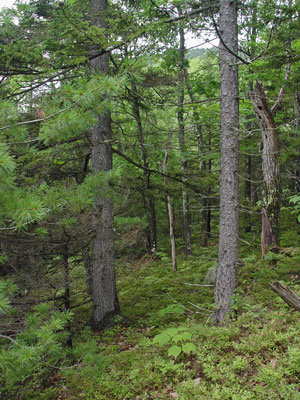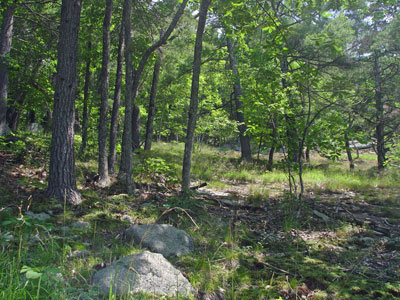DACF Home → Bureaus & Programs → Maine Natural Areas Program → Communities, Plants, and Animals → Natural Community Fact Sheets→ Oak - Pine Forest
Printer Friendly Fact Sheet - 820 KB pdf (Get a free copy of Adobe Acrobat Reader)
Oak - Pine Forest
Scientific Name: Oak - Pine Forest; State Rank: S5
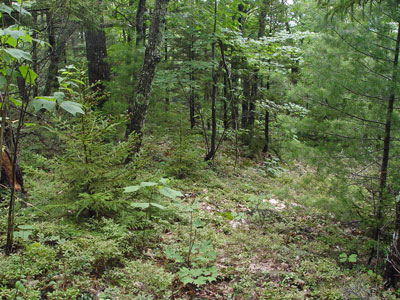
- Community Description
- Soil and Site Characteristics
- Diagnostics
- Similar Types
- Conservation, Wildlife and Management Considerations
- Distribution
- Characteristic Plants
- Associated Rare Plants
- Associated Rare Animals
- Examples on Conservation Lands You Can Visit
Community Description: This type is a closed canopy forest (>75% closure) in which red oak or a mixture of oak and white pine (rarely red spruce or hemlock) dominate. Red maple (up to 30% cover) and paper birch (up to 15% cover) can be common in younger stands. Striped maple is a common subcanopy associate; several other shrubs may be frequent. The herb layer is usually somewhat sparse (<30% cover), and features bracken fern, lowbush blueberry, and various herbaceous species; dwarf shrubs contribute 0-15% cover. The herb layer often includes forest species such as wild-oats and Indian cucumber-root that are seldom found in more open Oak - Pine Woodlands. Bryoids are sparse and are almost exclusively mosses rather than liverworts or lichens. Back to top.
Soil and Site Characteristics: Sites occur on lower to mid-slopes or occasionally upper slopes on low hills. Slopes are typically 10-25% and aspect varies. Sites are characterized by well drained mineral soils that are somewhat shallow (10-50 cm to obstruction), usually sandy loams or loamy sands, and acidic (pH ~5.0). Back to top.
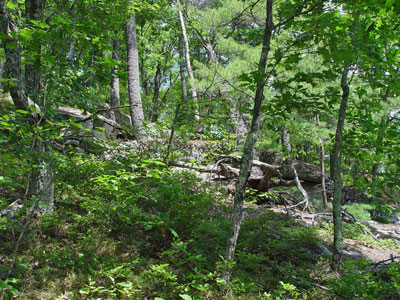
Diagnostics: These are more or less closed canopy forests with dominance of red oak or red oak - white pine mixture (occasionally red spruce or hemlock replace white pine); there is an absence or at least low cover of northern hardwood species and other oaks. Back to top.
Similar Types: Oak - Pine Woodlands are similar and sometimes contiguous with this type. Their canopy is more open and the dwarf shrub layer much more well developed (usually >15% cover of dwarf shrubs). Oak - Northern Hardwoods Forests occur on more mesic sites and feature at least 10% cover of other tolerant hardwoods (beech, sugar maple, white ash, or ironwood). White Oak - Red Oak Forests contain white oak in the canopy. Back to top.
Conservation, Wildlife and Management Considerations: Most Oak - Pine Forests in Maine are on land that was once cleared or pastured. The known sites are subject to fragmentation by timber harvesting, clearing for agriculture, and residential development. Fire or other soil disturbance may be important in maintaining this type. The community provides nesting habitat for a large number of passerine bird species such as the wood thrush, scarlet tanager, ovenbird, and pine warbler.
Mature stands with a high proportion of oaks offer excellent potential sites for cavity nesters. The state rare red-winged sallow moth uses red oak as one of its host plants and may be found in this community. Historical butterfly species like the persius duskywing and the frosted elfin were known from oak-pine forests and woodlands in southern Maine where their host plants, wild indigo and wild lupine, were formerly present. Similarly, this community type historically included chestnut as a canopy constituent and may include the chestnut clearwing moth, which uses chestnut as a host plant. Back to top.
Distribution: Extending southward and southwestward from southern and central Maine; this is common, matrix-forming forest type in the Eastern Broadleaf Forest Province. Landscape Pattern: Large Patch; formerly a matrix type in southern Maine and lower New England. Back to top.
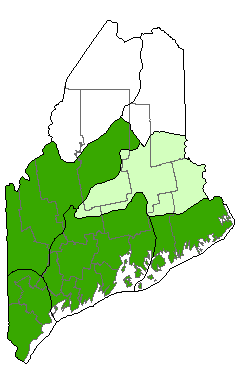

Characteristic Plants: These plants are frequently found in this community type. Those with an asterisk are often diagnostic of this community.
- Canopy
- American beech*
- Balsam fir*
- Paper birch
- Red maple*
- Red oak*
- Red spruce
- White pine*
- Hemlock
- Sapling/shrub
- Beaked hazelnut*
- Black huckleberry*
- Witch-hazel*
- Dwarf Shrub
- Lowbush blueberry*
- Black huckleberry*
- Herb
- Big-leaved aster*
- Bracken fern*
- Canada mayflower
- Starflower
- Bryoid
- Dicranum moss
- Large hair-cap moss
- Red-winged sallow
- Whip-poor-will
Examples on Conservation Lands You Can Visit
| Example | County |
|---|---|
| Bald Mountain, Little Concord Pond Public Lands | Oxford Co. |
| Sebago Lake State Park | Cumberland Co. |
